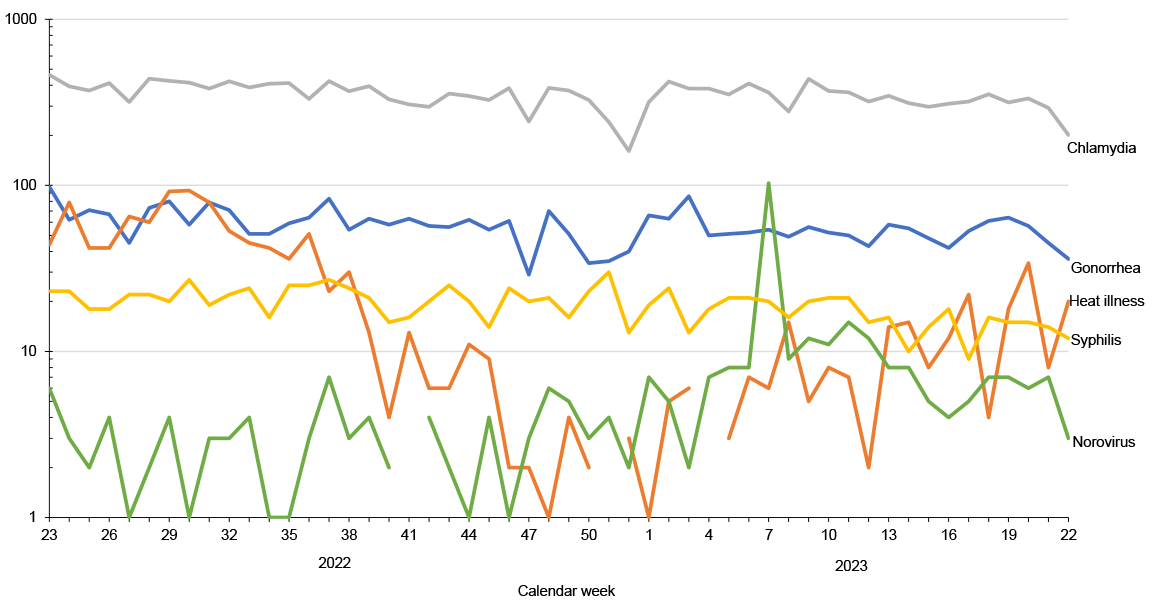Reportable Medical Events, Military Health System Facilities, Week 22, Ending June 3, 2023
 Graph depicting the frequency of the five most common reportable medical events within the Military Health System over the preceding year.
Graph depicting the frequency of the five most common reportable medical events within the Military Health System over the preceding year.
Reportable Medical Events are documented in the Disease Reporting System internet by health care providers and public health officials across the Military Health System for the purpose of monitoring, controlling, and preventing the occurrence and spread of diseases of public health interest or readiness importance. These reports are reviewed by each service’s public health surveillance hub. The DRSi collects reports on over 70 different RMEs, including infectious and non-infectious conditions, outbreak reports, STI risk surveys, and tuberculosis contact investigation reports. A complete list of RMEs is available in the 2022 Armed Forces Reportable Medical Events Guidelines and Case Definitions.1 Data reported in these tables are considered provisional and do not represent conclusive evidence until case reports are fully validated.

Total active component cases reported per week are displayed for the top five RMEs for the previous year. Each month, the graph is updated with the top five RMEs, and is presented with the current month’s (May 2023) top five RMEs, which may differ from previous months. COVID-19 is excluded from these graphs due to changes in reporting/case definition updates in 2023.

References
- Armed Forces Health Surveillance Division. Armed Forces Reportable Medical Events. Accessed April 6, 2023. https://www.health.mil/Military-Health-Topics/Health-Readiness/AFHSD/Reports-and-Publications/Armed-Forces-Reportable-Medical-Events
- Defense Manpower Data Center. Department of Defense Active Duty Military Personnel by Rank/Grade of Service, October 31, 2022. https://dwp.dmdc.osd.mil/dwp/app/dod-data-reports/workforce-reports
- Defense Manpower Data Center. Armed Forces Strength Figures for January 31, 2023. https://dwp.dmdc.osd.mil/dwp/app/dod-data-reports/workforce-reports
- Navy Medicine. Surveillance and Reporting Tools–DRSI: Disease Reporting System Internet. https://www.med.navy.mil/Navy-Marine-Corps-Public-Health-Center/Preventive-Medicine/Program-and-Policy-Support/Disease-Surveillance/DRSI
You also may be interested in...
Video
Oct 4, 2022
Rear Adm. Brandon L. Taylor, Director of DHA Public Health, discusses how vaccines greatly reduce the risk of severe disease, hospitalization, and death. "An ounce of prevention is better than a pound of cure." Lets us join Rear Adm. Taylor this year to get informed on how vaccines can minimize the dangers of flu.
Video
Jul 11, 2022
Learn more about Performance Nutrition and healthy eating habits at the Consortium for Health & Military Performance. https://champ.usuhs.edu/. For more information about the Dietician Approved Fueling stations at your local commissary, go to https://www.commissaries.com/fueling_stations
Video
Jul 11, 2022
Did you know that 75% of service members use at least 1 dietary supplement? Experts from the Uniformed Services University discuss the risks and safety concerns of dietary supplements. Learn more about dietary supplements at www.OPSS.org and The Consortium of Health & Military Performance (CHAMP).
Video
Jul 11, 2022
USU professor and nutrition specialist, Jonathan Scott PhD, gives advice on eating healthy. Learn more about the Dietician Approved Fueling stations at your local commissary here: https://www.commissaries.com/fueling_stations
Video
Sep 21, 2018
Interested in hearing about some exciting events that took place around the Military Health System last month? Tune in to the MHS Minute to learn more!
Video
Oct 5, 2017
U.S. Air Force Master Sgt. Rose Jane Schoenwandt, 349th Aeromedical Staging Squadron, Travis Air Force Base, California, and Staff Sgt. Caleb Boles, 445th Aeromedical Staging Squadron, Wright-Patterson AFB, Ohio, discuss the importance of moulage during Patriot Warrior.
Video
Apr 11, 2017
U.S. Navy Sailors and Military Sealift Command civilian mariners explain the mission of the USNS Mercy and its capabilities.
Video
Mar 23, 2017
Hemorrhage is responsible for 91.5 percent of potentially survivable battlefield deaths. From 2001 to 2011, an estimated 24 percent of combat deaths occurred before patients reached a treatment facility; the major cause of death was blood loss. Battlefield trauma innovations like the occlusion balloon catheter and freeze-dried plasma will enhance the ...
Video
May 19, 2016
Sailors with 2nd Medical Battalion got out of their comfort zone and conducted a week-long training exercise known as a Health Service Augmentation Program at Camp Lejeune, N.C., April 18-22, 2016.
Video
Dec 28, 2015
Corpsmen and Marines rehearsed life-saving skills during Exercise Steel Knight’s mass casualty drill, Dec. 12, 2015. Steel Knight provides tough, realistic training for the Marines and sailors of 1st Marine Division.
You are leaving Health.mil
The appearance of hyperlinks does not constitute endorsement by the Department of Defense of non-U.S. Government sites or the information, products, or services contained therein. Although the Defense Health Agency may or may not use these sites as additional distribution channels for Department of Defense information, it does not exercise editorial control over all of the information that you may find at these locations. Such links are provided consistent with the stated purpose of this website.
You are leaving Health.mil
View the external links disclaimer.
Last Updated: August 24, 2023